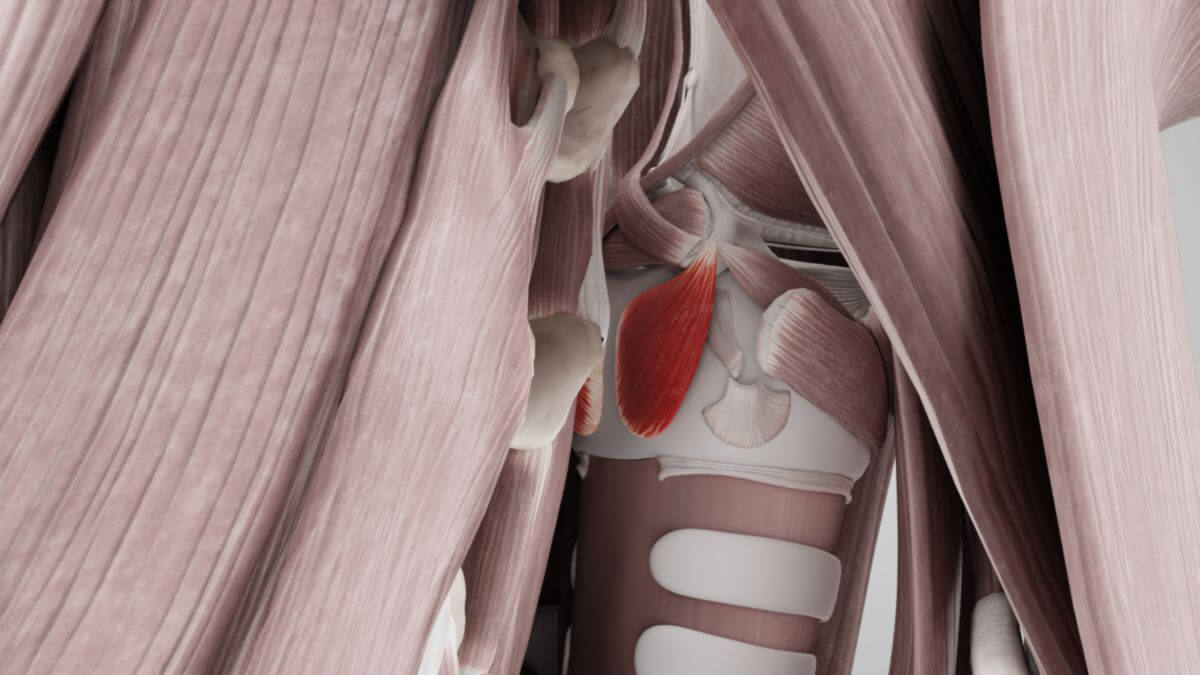Corpus: Posterior cricoarytenoid muscle: Unterschied zwischen den Versionen
Keine Bearbeitungszusammenfassung |
K (englischen Artikel überarbeitet) |
||
| Zeile 4: | Zeile 4: | ||
==Definition== | ==Definition== | ||
The '''posterior | The '''posterior cricoarytenoid muscle''' is part of the [[Corpus:Laryngeal musculature|laryngeal musculature]] and serves as the only [[Corpus:Muscle|muscle]] responsible for opening the [[Corpus:Glottis|glottis]]. It is commonly referred to as the "posticus" in clinical terminology.<dcembed ratio="16x9"><dcEmbedUrl src="https://www.doccheck.com/de/detail/photos/43343-musculus-cricoarytaenoideus-posterior"></dcEmbedUrl> | ||
<dcEmbedUrl src="https://www.doccheck.com/de/detail/photos/43342-musculus-cricoarytaenoideus-posterior"></dcEmbedUrl></dcembed> | <dcEmbedUrl src="https://www.doccheck.com/de/detail/photos/43342-musculus-cricoarytaenoideus-posterior"></dcEmbedUrl></dcembed> | ||
==Anatomy== | ==Anatomy== | ||
The posterior | The posterior cricoarytenoid muscle is located on the dorsal aspect of the [[Corpus:Larynx|larynx]], between the [[Corpus:Cricoid cartilage|cricoid cartilage]] (cartilago cricoidea) and the [[Corpus:Arytenoid cartilage|arytenoid cartilage]] (cartilago arytaenoidea). It originates from the posterior surface of the [[Corpus:Cricoid cartilage plate|cricoid cartilage plate]] (lamina cartilaginis cricoideae) and extends laterally upward to attach to the muscular process (processus muscularis) of the arytenoid cartilage. | ||
During contraction, | During contraction, the muscle rotates the arytenoid cartilage outward, rotating it around its vertical axis. This action lifts the [[Corpus:Vocal process|vocal process]] and moves it laterally, thereby opening the glottis.<dcembed ratio="16x9" caption="3D model of the larynx and thyroid gland. The posterior cricoarytaenoid muscle is labelled with the number 10."><dcEmbedUrl src="https://sketchfab.com/3d-models/modell-kehlkopf-und-schilddruse-f294da2a3a42486484595d502a131ea4"></dcEmbedUrl></dcembed> | ||
==Innervation== | ==Innervation== | ||
Like all internal laryngeal muscles, the posterior | Like all [[Corpus:Internal laryngeal muscles|internal laryngeal muscles]], the posterior cricoarytenoid muscle is innervated by the [[Corpus:Inferior laryngeal nerve|inferior laryngeal nerve]], a branch of the [[Corpus:Recurrent laryngeal nerve|recurrent laryngeal nerve]]. | ||
==Function== | ==Function== | ||
The posterior | The posterior cricoarytenoid muscle is the only muscle in the larynx that acts as a glottis opener, ensuring the "breathing position" of the glottis during [[Corpus:Inspiration|inspiration]]. Additionally, it works in conjunction with the [[Corpus:Cricothyroid muscle|cricothyroid muscle]] to tense the [[Corpus:Vocal cords|vocal cords]]. During sleep, the muscle's tone maintains an open glottis to ensure unobstructed airflow. | ||
The lateral cricoarytenoid muscle | The lateral cricoarytenoid muscle, along with the other three muscles that close the glottis, acts as an [[Corpus:Antagonist|antagonist]] to the posterior [[Corpus:Cricoarytenoid muscle|cricoarytenoid muscle]]. | ||
==Clinic== | ==Clinic== | ||
Unilateral paralysis of the posterior cricoarytenoid muscle (posticus paralysis), often due to recurrent laryngeal nerve damage, can result in hoarseness. Bilateral paralysis of this muscle leads to glottis closure, obstructing the [[Corpus:Airway|airway]] and causing acute dyspnea and inspiratory stridor. In such cases, an emergency tracheostomy may be required to secure the airway. | |||
[[Kategorie:Corpus]] | [[Kategorie:Corpus]] | ||
[[Kategorie:Head]] | [[Kategorie:Head]] | ||
[[Kategorie:Muscle]] | [[Kategorie:Muscle]] | ||
Version vom 8. August 2024, 17:52 Uhr
This text has been translated by an AI and may sound raw. It will be reviewed shortly. Thank you for your patience!
This text has been translated by an AI and may sound raw. It will be reviewed shortly. Thank you for your patience!
Synonym: posticus (clinical usage)
Definition
The posterior cricoarytenoid muscle is part of the laryngeal musculature and serves as the only muscle responsible for opening the glottis. It is commonly referred to as the "posticus" in clinical terminology.
Anatomy
The posterior cricoarytenoid muscle is located on the dorsal aspect of the larynx, between the cricoid cartilage (cartilago cricoidea) and the arytenoid cartilage (cartilago arytaenoidea). It originates from the posterior surface of the cricoid cartilage plate (lamina cartilaginis cricoideae) and extends laterally upward to attach to the muscular process (processus muscularis) of the arytenoid cartilage.
During contraction, the muscle rotates the arytenoid cartilage outward, rotating it around its vertical axis. This action lifts the vocal process and moves it laterally, thereby opening the glottis.
Innervation
Like all internal laryngeal muscles, the posterior cricoarytenoid muscle is innervated by the inferior laryngeal nerve, a branch of the recurrent laryngeal nerve.
Function
The posterior cricoarytenoid muscle is the only muscle in the larynx that acts as a glottis opener, ensuring the "breathing position" of the glottis during inspiration. Additionally, it works in conjunction with the cricothyroid muscle to tense the vocal cords. During sleep, the muscle's tone maintains an open glottis to ensure unobstructed airflow.
The lateral cricoarytenoid muscle, along with the other three muscles that close the glottis, acts as an antagonist to the posterior cricoarytenoid muscle.
Clinic
Unilateral paralysis of the posterior cricoarytenoid muscle (posticus paralysis), often due to recurrent laryngeal nerve damage, can result in hoarseness. Bilateral paralysis of this muscle leads to glottis closure, obstructing the airway and causing acute dyspnea and inspiratory stridor. In such cases, an emergency tracheostomy may be required to secure the airway.


